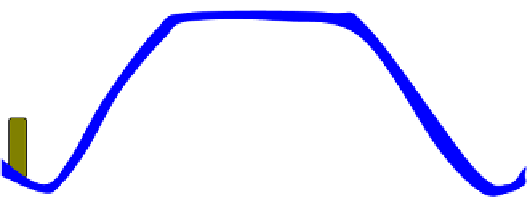Biomedical Engineering Reference
In-Depth Information
RNA nucleotides
RNA polymerase
T
T
A
C
C
A
A
U
T
C
T
G
U
G
A
C
A
A
C
C
C
U
C
A
G
A
TA
G
G
T
T
Direction of transcription
DNA template strand
Newly made mRNA
FIGURE 10.7
A schematic of mRNA synthesis as catalyzed by the RNA polymerase.
important role in initiation. The
s
factor recognizes a specific sequence of nucleotides on
a DNA strand. This sequence is the promoter region. Promoters can vary somewhat, and
this alters the affinity of the
s
factor (and consequently the holoenzyme) for a particular
promoter.
Table 10.1
shows the promoter sequences in prokaryotes and eukaryotes. As one
can observe from
Table 10.1
, the promoter region starts from 10 to 80 nucleotides prior to
the start codon ATG. A strong promoter is one with a high affinity for the holoenzyme. The
rate of formation of transcripts is determined primarily by the frequency of initiation of tran-
scription, which is directly related to promoter strength. This will be important in our discus-
sions of genetic engineering (Chapter 14). Cells usually have one dominant
s
factor that is
required to recognize the vast majority of promoters in the cell. However, other
s
factors
can play important roles under different growth conditions (particularly stress) and are
used to initiate transcription from promoters that encode proteins important to the cell for
coping with unusual growth conditions or stress.
After the initiation site (a particular ATG codon) is recognized, elongation of the transcript
begins. The synthesis of the growing RNA molecule is energy requiring, so activated triphos-
phate monomers of the ribonucleotides are required.
TABLE 10.1
The Conserved DNA Promoter Binding Sequences in
Bacterial and Eukaryotic Polymerases
Cell type
Promoter binding location
Promoter sequence
Prokaryotic
10
TATAAT
TTGACA
35
Eukaryotic
25
TATA
CAAT
80




















































Search WWH ::

Custom Search